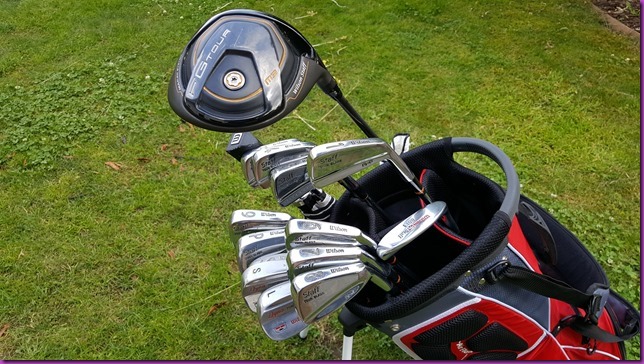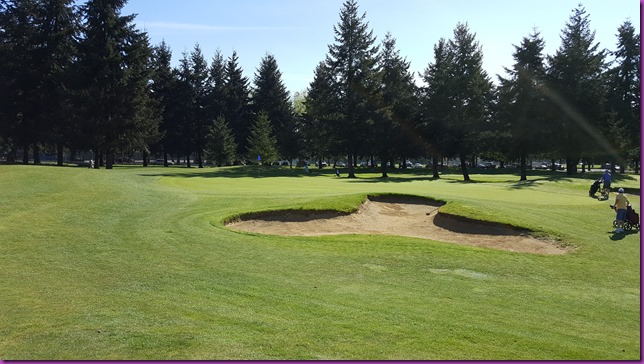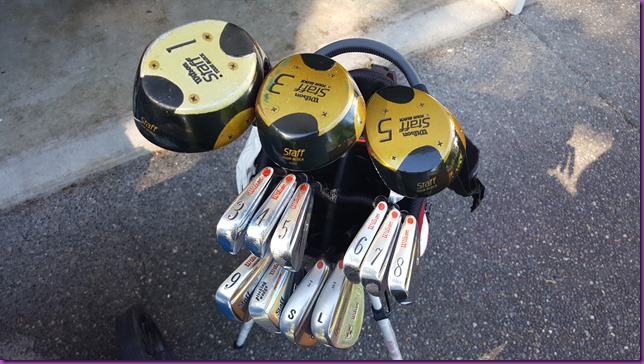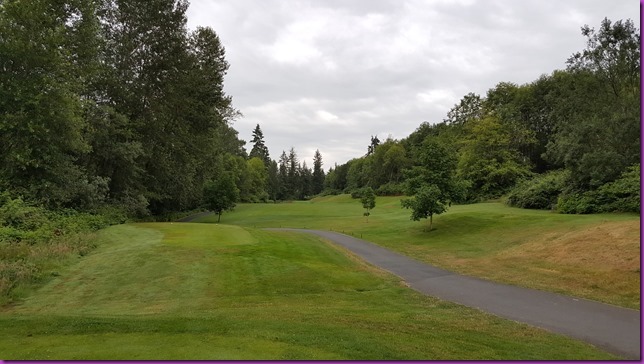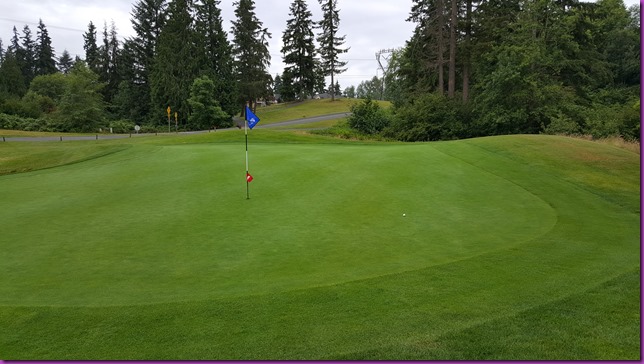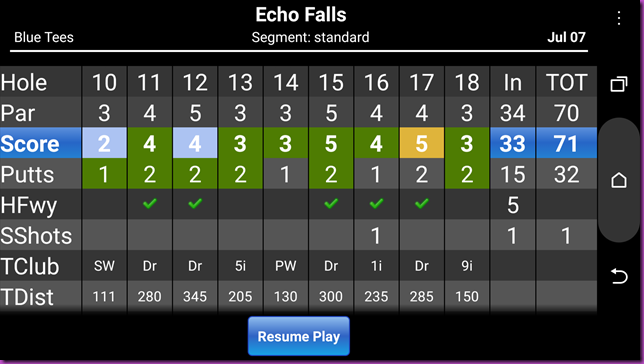
In honor of The Open Championship this week, I decided to throw my budget out the window and double what I normally would on a round of golf. Of course, I was also on vacation this week, travelling to Seaside, Oregon for my daughter’s dance team’s trip to the Spotlight Nationals, so budget-smudget, right? After checking out the area courses, the only one that seemed like a challenging play was the Gearhart Golf Links. Designed in 1892, the Golf Links are the oldest course in Oregon. At $75 weekdays and $85 weekends, it’s also one of the more affordable “premium” courses in the area as well. The 4 different sets of tees will fit a golfer of just about any level, but for my game, it was the 6501 yard (72.0/136) “The Stones” that were getting my tees today. There are a few more options for those with lesser length off the tees. These include the Black (6176/70.5/131), White (5741/68.5/126 men or 75.0/131 women) or Green (5157/65.6/118 men or 71.1/126 women). Any way you slice it, The Links are a battlefield lined with undulating fairways and crazy bunkers that guard some small, but challenging greens.
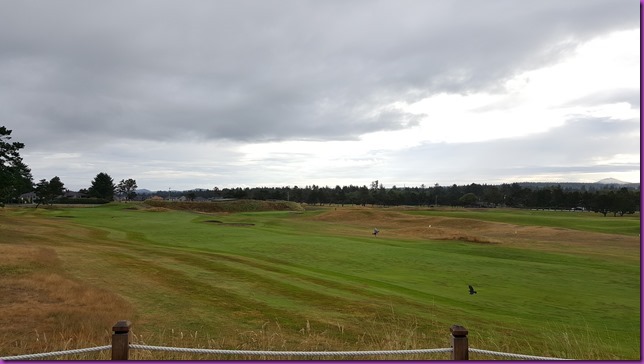
The view from the first tee, a par 4 that measured 330 yards from the tips, was stunning. What looked to be nothing more than a flat fairway with minimal trouble ended up producing some strange lies and had a few surprises for us in it. I ripped a driver into the wind and landed 275 yards down the fairway. A lob wedge landed me within 2 putt distance and the round was underway with a solid par. The second hole, which was across the road, demanded a lower tee shot, for which my 220 yard 1 iron fit the bill nicely. My wedge to the green was caught by the wind and pushed a bit left, which left me an up and down for an easy par. The next hole blew my mind, it was a par 4 that measured 268 yards into the wind. A solid 1 iron landed 40 yards short of the green and my wedge landed just feet from the hole on my “approach shot” for this hole. I have to admit to getting lucky on my putt on this hole, as it would have run 10 feet past if it hadn’t hit the center of the hole. Thank goodness for air brakes on this one. The birdie 3 put me 1 under after three holes.

Moving on to the 4th, a par 3 that measured 217 yards, I once again found a side wind playing havoc with the hole. My 3 iron went 220 off the tee but headed left of the green. The resulting pitch to a downhill green with zero room to work had me running a two putt back for bogey and returned me to even par. The 5th, a par 4 that measured 369 yards was simply stunning. A strong drive, into the wind only travelled 220 yards up the hill before it was snagged in the right rough. The 9 iron that followed missed the green a touch left, but left me an easy chip and put for a par. The par 4 6th played much more traditionally for me. At 348 yards, this hole was more about avoiding the trouble around it than anything else. A 285 yard drive down the center left me a solid 58 degree wedge to the green. I parked the wedge at 10 feet and 2 putted for my par. That left me even after 6.

Moving on to the 7th hole, a 339 yard par 4, a beautiful 1 iron draw found the fairway, but my 115 yard 54 degree wedge did not find the green. Fortunately, from the right edge, I was able to chip to 2 feet and tap in for my par. This brought me to the first par 5 of The Links, which measured in at 487 yards. Nothing too tricky on the 8th hole, except for the elevation change. My driver “blasted” the ball 200 yards up the hill, which was far less than it felt like it was going to go. I followed that with a setup to get to my 100 yard wedge to the green. 2 putts later, that par 5 was done and I was still at even par. Finishing out the front side, was the 373 yard par 4 9th. It was long, straight and easy, as long as you stay in the narrow fairway. Fortunately I was able to do just that and hit driver, PW and a chip and a putt for another par and an even 36 on the front side.

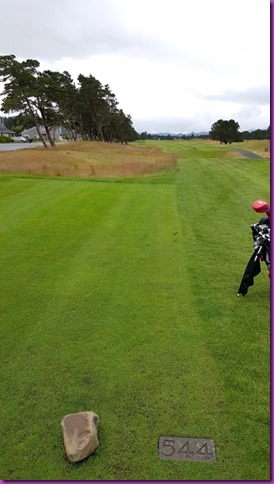
Length starts to become a bit more fun on the back side of the course. The front side measures just 3087 yards from The Stones, but the back lengthens out to 3414 yards. This gives is more of the champion tee feel that I was expecting, but also, created a much more challenging shot selection in the winds that were blowing across the course. The 351 yard par 4 10th begins the journey away from the club house again. My 1 iron found the fairway with ease, but the 8 iron approach carried to the back edge of the green. Again, a chip and a putt moved me along to the next hole without any major incident. The par 3 11th… WOW! This hole measures up at 262 yards from the tips. With the wind blowing at me, I pulled out a driver to try and hit the 5 yard wide target, which I came pretty close to doing. The pin was placed on a side hill, which only added to the difficulty of stopping a chip near it, and I walked away with a bogey 4. What an impressive challenge though1 Don’t worry, if you are playing the Green or White tees, it is a much more manageable 183 or 122 from those. The par 4 12th seemed like a breeze after that, though my 8 iron approach missed the green to the right, resulting in a chip and 2 putt for bogey on it as well. After 12, I had moved to two over par.
The 544 yard par 5 13th was finally a break from the hard holes, and I only say this because, well I managed to scrape together a par on it. The irony on 13 was that I played that hole very wild with my drive going right, my next approach shot getting topped out of the rough into the fairway and then a second effort at that shot before landing my FG49 SW about 3 feet from the flag. It wasn’t pretty, but it was a par. The 14th played much cleaner for me. The 371 yard par 4 took just two simple shots to reach, a solid 1 iron off the tee and a good pitching wedge on the approach. Two putts later, my par was on the card. Moving right along to the 15th, I almost threw a party when I nailed my FG49 SW on the screws and landed about 10 feet past the flag on the short par 3. The ball hit, and immediately spun backwards to about 3 feet from the hole. My tap in birdie was almost a hole in one, but not quite.
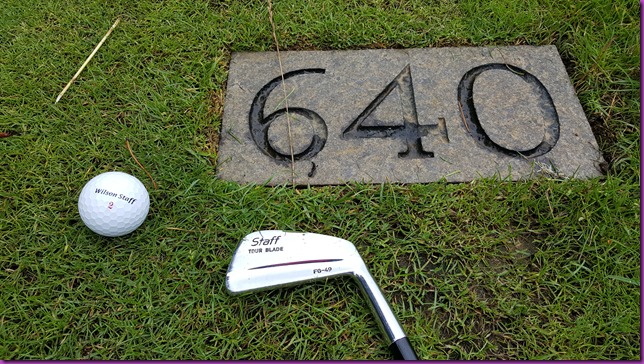
The 16th played rather uneventful, or at least not as exciting as the par 3 that almost was a hole in one, Still, a long drive right left me a short 58 degree wedge to the green. Two putts later and the 16th was a par. 17 also played long at 347 yards. With the wind coming at me on this one, I teed up a 1 iron and drove the ball down the center of the fairway. I hit my FG49 sand wedge to 10 feet and two putted for par. This left me only the 640 yard par 5 18th left. I hit a strong 1 iron down the middle of the fairway. I followed that with a drawing 3 iron and a solid 5 iron before I saw my ball had rolled back to the bottom of the hill below the green. A lob wedge and 2 putts later, I finished my round 2 over par. The 74 that I landed at Gearhart Golf Links was one of the best rounds I have played.
Gearhart was a joy to play. The links style layout was gorgeous and the course was well maintained. Even with my early morning round, bunkers were all raked, fairways were trimmed short and the greens rolled true. From rolling up to the parking lot, to the friendly face behind the pro shop counter, Gearhart will be on my list of courses to play anytime I am near it. At $75, it wasn’t the cheapest round of golf I’ve ever paid for, but it was certainly one of the best values. In fact, I wouldn’t even hesitate ponying up $100 to play this course again. It was an amazing experience and I can’t wait to go back again sometime soon.
